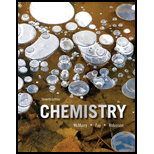
Concept explainers
(a)
Interpretation:
The position at which repulsive forces are high between the two atoms should be identified.
Concept introduction:
When two atoms are very close to each other repulsion occurs.
When two atoms are very far to each other, no repulsion occurs.
When distance between atoms is optimum there will be maximum attractions the energy is very.
Interpretation:
The position of the two atoms which neither exerts attractive nor repulsive forces on one another should be determined.
Concept introduction:
When two atoms are very close to each other repulsion occurs.
When two atoms are very far to each other, no repulsion occurs.
When distance between atoms is optimum there will be maximum attractions the energy is very.
Interpretation:
The position at which the attractive forces between atoms that are maximized which results in the lowest energy state should be determined.
Concept introduction:
When two atoms are very close to each other repulsion occurs.
When two atoms are very far to each other, no repulsion occurs.
When distance between atoms is optimum there will be maximum attractions the energy is very.
Interpretation:
The position at which the attractive forces are present but are not at maximum strength should be determined.
Concept introduction:
When two atoms are very close to each other repulsion occurs.
When two atoms are very far to each other, no repulsion occurs.
When distance between atoms is optimum there will be maximum attractions the energy is very.
Want to see the full answer?
Check out a sample textbook solution
Chapter 7 Solutions
Chemistry (7th Edition)
 ChemistryChemistryISBN:9781305957404Author:Steven S. Zumdahl, Susan A. Zumdahl, Donald J. DeCostePublisher:Cengage Learning
ChemistryChemistryISBN:9781305957404Author:Steven S. Zumdahl, Susan A. Zumdahl, Donald J. DeCostePublisher:Cengage Learning ChemistryChemistryISBN:9781259911156Author:Raymond Chang Dr., Jason Overby ProfessorPublisher:McGraw-Hill Education
ChemistryChemistryISBN:9781259911156Author:Raymond Chang Dr., Jason Overby ProfessorPublisher:McGraw-Hill Education Principles of Instrumental AnalysisChemistryISBN:9781305577213Author:Douglas A. Skoog, F. James Holler, Stanley R. CrouchPublisher:Cengage Learning
Principles of Instrumental AnalysisChemistryISBN:9781305577213Author:Douglas A. Skoog, F. James Holler, Stanley R. CrouchPublisher:Cengage Learning Organic ChemistryChemistryISBN:9780078021558Author:Janice Gorzynski Smith Dr.Publisher:McGraw-Hill Education
Organic ChemistryChemistryISBN:9780078021558Author:Janice Gorzynski Smith Dr.Publisher:McGraw-Hill Education Chemistry: Principles and ReactionsChemistryISBN:9781305079373Author:William L. Masterton, Cecile N. HurleyPublisher:Cengage Learning
Chemistry: Principles and ReactionsChemistryISBN:9781305079373Author:William L. Masterton, Cecile N. HurleyPublisher:Cengage Learning Elementary Principles of Chemical Processes, Bind...ChemistryISBN:9781118431221Author:Richard M. Felder, Ronald W. Rousseau, Lisa G. BullardPublisher:WILEY
Elementary Principles of Chemical Processes, Bind...ChemistryISBN:9781118431221Author:Richard M. Felder, Ronald W. Rousseau, Lisa G. BullardPublisher:WILEY





